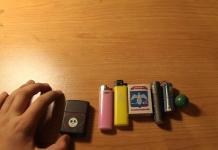A device for sharpening knives with your own hands is required device for any work in the kitchen or workshop. Using perfectly sharp knives makes cooking much easier, allowing you to use less force when cutting meat, slicing vegetables or bread. Working with a dull knife is not only inconvenient, but also dangerous, because such a tool can fall off the material being cut at any moment and cause injury to you.

Using a homemade knife sharpener, you can sharpen a knife at any angle, since the sharpening angle is independently adjustable.
In order to bring any knife to a sharp state, you should know the optimal sharpening angle. This parameter depends on the grade of steel and the purpose of the knife. Homemade tools will help you install the knife under the right angle to sharpen it quickly and efficiently.
How to sharpen knives correctly

Figure 1. Device for sharpening knives “Domik”.
Some types of kitchen knives cannot be sharpened yourself. These include tools special form(for example, a bread knife or other types of knives with a raised edge). You should also not sharpen ceramic knives. However, the advantage of the listed tools is that manufacturers try to make them from especially hard grades of steel, so they do not become dull for a long time.
For proper sharpening, you should select good abrasives of different grain sizes. Store-bought versions of such bars are quite expensive, but you can always make a block yourself from a piece of wood covered with fine sandpaper. It is important to have devices of different grain sizes: large ones for preliminary “grinding”, and small ones for grinding.
The optimal sharpening angle for a knife edge is from 20 to 30 degrees, depending on functional purpose tool. It is quite difficult to sharpen manually at this angle, so simple homemade mechanisms are used for this purpose.
Return to contents
Assembling a knife sharpening device
Among the many tools for sharpening knives with your own hands, you should choose the one that will best suit your goals. All devices have a fairly simple structure and consist of two main parts:
- stop for securely fastening the knife;
- a movable block of abrasive material.

Figure 2. Wooden body in the form right triangle to place the whetstone.
The simplest tool for creating a sharp edge on a blade is called a “house” (Fig. 1). It looks like a rectangular or wooden block square shape, the upper edge of which is processed in the form of a gable “roof”. The angle of inclination of the edges of such a block is 20-25°. The knife to be sharpened is placed with its edge close to the ridge of the “roof”. Making movements with an abrasive stone in horizontal plane along the blade, we will ensure that the sharpening angle remains constant.
There are also quite complex devices. To create them you will need some materials, tools and a little time, but you will provide yourself with a convenient sharpening tool for a long time. The device is assembled from the following materials:
- wooden board, dimensions 500x150x20 mm;
- metal studs, 8 mm in diameter with thread;
- several M8 bolts and nuts, wood screws;
- wing-type clamping screws;
- textolite or piece of steel for the pressure plate;
- optional neodymium magnet for securely holding the knife during the sharpening process.
From wooden board you need to make the body in the form of a right triangle, and the lower leg should be slightly longer, since a stand for the grindstone will be placed on it (Fig. 2). The inclined board is attached at an angle of 20° to the base. A hole is made in it for attaching the pressure plate, through which a screw with a wing nut will pass.

Figure 3. It is necessary to drill a hole for a vertical pin, which will serve as a holder for the abrasive device.
Near acute angle structure, you need to drill a hole for a vertical pin, which will serve as a holder for a movable abrasive structure (Fig. 3). A small one is put on the hairpin wooden block, which is clamped with a screw and a clamping nut.
The last element of the device is another pin with a clamp holder for an abrasive whetstone (Fig. 4). Clamps can be made independently from wood, metal, ebonite or other material, or you can use a disassembled clamp for this. For better stability You can glue rubber feet to the bottom of the tool (video 1).
In order to sharpen a knife using such a device, it is placed on a magnet, and if there is no magnet, it is pressed against the stop, holding it with your hand. The angle that occurs between the surface of the knife blade and the horizon provides optimal sharpness for kitchen knives. By making longitudinal movements with the holder with an abrasive stone, you need to achieve a sharp edge of the knife, then turn it over to the other side and repeat the steps.
As abrasive bars, you can use ready-made products that you can purchase at a hardware store or make them yourself. For this, small rectangular glass plates, 4-5 mm thick, are used. Using double-sided tape, sandpaper of different grain sizes is glued to their surface. The cost of such bars is very low, and the sandpaper can be replaced with new sandpaper at any time. The only caution is to tighten the clamp nuts carefully, otherwise the glass may easily break.
One of the problems that arises when using such a device is rapid wear of the abrasive, since water is not used during operation. For the same reason, too fast movements should be avoided, leading to overheating of the metal and loss of properties. cutting edge.
Return to contents
Typical mistakes when manually sharpening knives

Figure 4. Hairpin with clamp holder for an abrasive stone.
If you are not sharpening knives professionally, but are one of the people who use these tools only at home, then before you start sharpening them yourself, you should learn about some typical mistakes newbies:
- The first and most common mistake is not sharpening the cutting edge. It consists in the fact that when working with abrasives on work surface When cutting a knife, many small burrs are formed, which create a feeling of sharpness of the knife. After the first few uses, the burrs fall off and the blade becomes dull again. To prevent this from happening, it is important to sharpen the tool to the end. For a more detailed examination of the cutting edge, you can use a magnifying glass - it will allow you to control correct execution process.
- Presence of dirt on the blade. Under no circumstances should you sharpen a dirty, greasy knife. Sometimes you can see how professional chefs, in the process of cooking, take a round file with a handle - musat, run it over the tool several times and continue to work. But this is not a sharpening accessory; this device is used only for leveling the edge of the knife.
- It is important to avoid not only dirt, but also the remnants of previous, larger abrasives, since they easily mix with the fine grinding material, leading to scratches and unevenness.
- Pressing too hard. The sharpness of a knife does not depend on the force applied to the block, but on the duration and accuracy of sharpening. Too much pressure causes the cutting edge to break off.
- Wrong choice of sharpening angle. This parameter depends on two indicators: the purpose of the tool and the grade of steel from which it is made. For kitchen knives, the optimal angle is 20 to 25 degrees. Tourist, hunting and fishing knives must withstand heavy loads without becoming dull. For them, the edge angle is up to 40 degrees. For comparison: the sharpness allowing the knife to be used as a razor is 10-15 degrees.
Greetings, Samodelkins!
Today I want to show you how you can use the materials that are (or at least should be) in almost every workshop to make an excellent device for sharpening knives evenly.
Initially, the master wanted to buy a ready-made device for sharpening knives in China (namely in the Aliexpress online store), but he thought why not try to make such a sharpener with his own hands. Moreover, the prices for this product from Chinese friends are rather high.
For self-made will be needed following materials and tools:
1. Ordinary board;
2. Sandpaper;
3. Screwdriver;
4. Hammer;
5. Thick electrode 1 pc;
6. Jigsaw;
7. A piece of laminate;
8. Bolts and nuts;
9. Wooden handle;
10. Hex key;
11. Fluoroplastic or textolite (fiberglass).

Let's get down to actually making the sharpener.
First, let's take an ordinary board and cut a piece out of it. Then you need to process the resulting wooden blank, namely sand it with sandpaper.



It will serve as the base for our homemade sharpening device.
In terms of size, we get it to be 26 cm in length, the width of the workpiece is 6.5 cm, and the height of the wooden base is 2 cm.



You also need to make holes in this board. In total, this part of the future product will have 6 through holes. We drill 2 holes for the stand itself (more on that a little later). Nearby we drill another hole of a smaller diameter, and also on the other side of the board we drill 3 more holes that will serve to attach the pressure plate.

Insert nuts into the holes made.

In the future, these nuts can be placed on glue so that they do not fall out, but for now everything seems to be quite tight.
Then we will start making the guide post itself. The master made it from an ordinary thick electrode. It needs to be bent in half. Next, using a hammer, the author beat off welding electrode all top part and sanded it down. By the way, you can also grind using an ordinary screwdriver. To do this, simply insert the electrode into the screwdriver chuck and, holding sandpaper in your hand, grind the product.







At this stage, we insert the resulting workpiece (guide post) from the electrode into these two holes.
We insert it not at a right angle, but at a slight angle. The guide angle is somewhere between 65 and 70 degrees.



Everything fits quite tightly, but also for greater reliability of our design, in the future it will be possible to attach the guide post with epoxy glue, or with some other glue, or with something else.


But perhaps the master is mistaken and this is not fluoroplastic. Fluoroplastic is most often white and somewhat slippery. Most likely it is textolite or fiberglass. But in essence it’s not that important. The main thing is that this material is quite hard and does not wear off.
From this piece (fluoroplastic or non-fluoroplastic), the author cut out a kind of pressure plate. He made holes in it, as well as small recesses, so that the caps would extend slightly into the depths of the plate.





Then we place this plate on the previously made wooden base. Secure with screws.


The author took the screws with a hex key. The master also made a small hole in the base of the future knife sharpener so that this key would always be in this sharpener.



The whole thing is clamped and they (the screws) are actually not visible on the plate.
But here, the master did not do the countersunk work, since the sharpening part of the tool will not touch this screw.

Next, the author made such a plate from the same fluoroplastic.

In this plate I made 2 holes for the same hexagonal screw.
Next, the whole thing is placed here and pressed with the help of a lamb.



Then the master made a guide like this for the sharpening stones.

The length of the guide is 57 cm. The author made it from an ordinary steel rod. Also cleaned it up. And on one of the ends I put this handle (it looks like it came from an old Soviet file).

You can also strengthen this connection by placing the wooden handle of the file on the glue, but here it fits in quite tightly, nothing falls out.
Regarding the attachment of the sharpening stones themselves. The author took a small piece of the clamp, cut it and made holes. As a result, we got corners like this, two identical.



And here I put a nut with a thread and a clamping screw.


The master also installed a spring on the guide so that sharpening stones could be changed without unscrewing the nut with the clamping screw.

The author made the sharpening stones themselves, or rather the base for these stones, from an ordinary piece of laminate. Just cutting it into strips.



The width of the strips is 2.5 cm, and the length is about 20 cm.


The pieces of laminate already have ready-made grooves, which is where the corners of the guide part of the device will go.
Then the author stuck sandpaper onto the laminate pieces using double-sided tape and labeled which one went where. And, in fact, this is how it all turned out:


This whole thing is quite easy to set up. Using the groove of the laminate we get into one corner of the guide, and with the help of a spring we press the sharpening stone with the second corner.



All. Nothing falls out anywhere. Everything lies flat and quite tightly.
Let's continue assembling our device. We insert the guide with the sharpening stone attached to it into the hole prepared in advance for it, and you can safely begin the process of sharpening the knife.


The stroke is quite large due to the fact that here the author removed a small chamfer on both sides.
Every man, and sometimes even a woman, regularly faces the need to sharpen a knife. Every knife, regardless of quality, can become dull over time, so it requires careful care. Found on store shelves large selection sharpeners and sharpening stones, so making a choice will not be difficult.
Types of sharpening stones
There are several types of stones that are used for sharpening knives:
- Oil-based - such stones involve the use of oil on the surface, which saves material consumption.
- Water stones - have the same principle of operation, but water is used to work with them.
- Natural stones are natural materials that have been industrially processed.
- Artificial stones, accordingly, are made from a non-natural component.
- Rubber stones, such material is rare, as they are not convenient to work with.
Some features of knife sharpening
Each knife has its own sharpening feature.
For example, a Japanese knife, for self-sharpening, requires the attention of an experienced craftsman, since Japanese steel is very fragile. Manufacturers recommend using several types of Japanese for sharpening water stones, with different grain sizes.
For housewives, it is easier and more convenient to use a special sharpener to sharpen a kitchen knife. However, using several stones will keep the knife sharper for longer. long time, which is especially appreciated. Although this will take more time and effort, it will extend the life of the tool.
Conditions for proper sharpening of knives
To properly sharpen a knife, it is necessary to create conditions under which the knife will remain sharp for several months. For such sharpening, choosing the right angle will help. There is a rule that determines correct principle work - a smaller angle for sharpening a knife will create less strength of the cutting edge. That is, it should be remembered that the sharper the knife is immediately sharpened, the faster the time will come for re-sharpening, and the more difficult it will be to bring the knife to its original working condition.

Why do you need sharpening?
The main point of sharpening knives is to restore the sharpness of the blade itself. Why you need to comply correct angle when sharpening. Or rather, restoration of the previously specified angle, which must comply with technological standards. To check the sharpness of a knife, it is necessary to cut the material for which it is intended; if the knife cuts it without problems, then the technique has been followed correctly.
Problems that may arise when sharpening
Without a doubt, to select the appropriate angle, experience is required, without which it is quite difficult to cope with this task. Especially without necessary equipment, since holding the knife with your hands makes it difficult to sharpen it evenly on both sides. To fix the problem, it is recommended to build homemade machine for sharpening knives, which is easy to do at home. After all, the existing devices are quite simple in design and are not distinguished by their complexity.

How can you sharpen a knife at home?
There are situations when you need to sharpen a knife very quickly at home; for such purposes you can use the following available materials:
- wooden block;
- hacksaw;
- sandpaper;
- file;
- ceramic plate;
- chisel and some others.
Particularly sophisticated village men In general, they can sharpen a knife on a foundation made of a solution of cement and sand. However, it is not recommended to follow this example, but use in practice the most proven methods that are suitable for quick sharpening.
The most the best way there will be production homemade device, since it is effective and very convenient, and besides, it will differ little from the factory one.

What are the drawings for?
Of course, purchasing a ready-made knife sharpener is much easier, and they are not so expensive. Still, most home-conscious owners prefer to do everything with their own hands, this is pleasant and you can be confident in the quality of workmanship. After all, they are only used natural materials. To make the manufacturing process enjoyable and simple, you need to prepare a plan and follow it.
- To begin with, it is manufactured or purchased finished drawing for clamping jaws. When making a drawing, it is necessary to pay special attention to the smallest details and think through and draw the entire structure.
- The next step will be to draw a drawing of the right and left stops, for the strength of the assembled structure.
- Make a drawing for a guide, which has its own subtleties.

Guide drawing
All you need for a guide that will fit perfectly is the following:
- A spool with an M6 thread, which must be sawed off using a hacksaw so that it is 16 cm long. The main thing is to ensure that there are no burrs so that they do not slow down the sharpening process itself.
- Also, electrodes with a soft and elastic cylinder can be useful in work; they need to be bent into the letter “g” using pliers. The main thing during the work period is not to forget to periodically look at the product drawing.
- Metal scraps are useful for using clamps; they need to be cut and holes installed using drilling machine. A hand tap will help in marking the threads. And in order to reduce friction, use a drop of oil, which can subsequently be easily removed with a soap solution.
- When finishing work with the guide, according to the drawing, you should twist all the parts and, for fixation, drop regular nail polish onto the junction of the clamp and the pin.

There are two types of knife sharpening: double-sided and single-sided. The operating principles of these two are, of course, different. All that needs to be taken into account when working with knives are criteria such as:
- Abrasive stone used when working with knives should not have very small or, conversely, very large grains; choose something in between these two criteria.
- In the case when there is no necessary device for sharpening a knife, but the tool needs to be sharpened, you can use this improvised means, like a ceramic mug. All you need to do is turn the spontaneous sharpening over and move it towards you along its bottom. But it is worth considering that its bottom should have a rough surface.
- Don't forget that ceramic knives do not need sharpening. Their surface is coated with a special coating made of special alloys, which protects it from damage and wear.
- A serrated knife should not be sharpened without special equipment; there is a high probability that you will not sharpen it, but will ruin it. For this kind of knives, a special laser is used.
- To keep knives sharp longer, they should be washed in cold water.
Knife sharpening errors
Features of sharpening planing knives
This kind of knives can only be handled by experienced master with certain skills and knowledge. Since this is a very complex process, sharpening equipment is difficult to find in a regular store. However, many people use conventional equipment to sharpen planer knives. But we must remember that this requires a modern, low-speed, water-cooled tool. You should also use a new stone, with flat surface, would be better suited a stone that has a water principle of operation. If you are not an expert and you do not have necessary equipment, you can sharpen a planer knife for a fee at car workshops where such a sharpener is available.
Video
With repeated use of knives, every housewife faces a problem when they begin to become dull and it becomes simply impossible to work with them. In addition, this is unsafe, since the knife can slip while cutting and injure you. To prevent this from happening, knives should be sharpened in a timely manner using a special sharpening device.
You can buy a knife sharpener at your nearest hardware store or at the market, where they will offer you various types devices. You will have to choose yourself. But in order not to make a mistake, you need to know how to correctly evaluate them in terms of convenience and quality of use.

The offered options do not always satisfy consumers, so many make sharpeners with their own hands, using special stones, tools and drawing sketches with dimensions. The photo shows options for homemade knife sharpeners.

Features of knife sharpening
When sharpening knives, the main thing is to make the correct angle of contact between the edges of the blades so that they serve you for a long time and effectively. Therefore, when sharpening knives yourself, it is necessary to maintain the existing angle of the blades.

Each knife blade has its own characteristics optimal angles tilt:
- from 10 to 15 degrees - for a medical scalpel or straight razor;
- from 15 to 20 degrees – for household knives used for cutting bread products, vegetables or fruits;
- from 20 to 25 degrees – for multifunctional knives for cutting a variety of products;
- from 25 to 30 degrees – for reliable companions of hunters and tourists on long hikes;
- from 30 to 40 degrees – for cutting materials that are particularly hard.









To sharpen the correct angle of the blade, you cannot do without special tools, since it is difficult to do this manually.

The design of such devices is not complicated, so it is easy and quick to make it yourself, and detailed instructions for making sharpeners you can borrow from the Internet.

Types of knife sharpeners
From a large assortment various types select knife sharpeners the right option simple enough for yourself.

The main elements of the sharpening device are a stop for fixing the knife and an abrasive stone, which is used as ready-made abrasive materials (stones) or self-made. But before you get to work, you need to learn how to properly make a knife sharpener with your own hands.

Types of sharpening stones
There are several varieties sharpening stones:
- aquatic. Sharpening stones used in water are less likely to wear out during use.
- oil The structure and configuration are similar to aquatic ones, but with a more oily surface.
- natural. For their production we use only natural raw materials with pre-treatment in the production process.
- artificial. In this case, the name speaks for itself, i.e. the abrasive material is created artificially.
- rubber. They are not as common as the previous ones, and they are also inconvenient during use.

What can you make a sharpener from?
To do whetstone with your own hands, you can use the most in a simple way. Take a small glass plate rectangular shape about 5 mm thick. Using double sided tape Secure it on both sides with strips of coarse and medium-grit sandpaper.

The block is ready for use; if necessary, worn sandpaper can be easily replaced with a new one. This method is the most budget-friendly.









The disadvantages of this device include:
- rapid wear of the abrasive and fragility of the product (when fastening the timber you need to be careful that the glass does not crack).
- possible overheating of the material during rapid movements during the sharpening process.

You can find the best ideas for knife sharpeners on their respective websites.

Wooden bars
This method of making a tool for sharpening knives is also simple and accessible to everyone. You will need four identical bars: two abrasive and two wooden.

Before starting work, sand the wood blocks with sandpaper so that their surface becomes smooth without burrs. Mark the block according to the required angle of inclination. Apply a whetstone and mark its width on a block of wood.

Pay attention! 
Make cuts 1.5 cm deep according to the mark and insert abrasives into the grooves. Secure the stones with bolts. A piece of rubber attached to the bottom will give the structure stability.

In addition, you can make an adjustable sharpener with your own hands, but the next article will tell you how to do this.

Photos of DIY knife sharpeners






Pay attention! 










Pay attention! 
















A DIY knife sharpener will be very useful in the household.
With the help of fairly simple ones you can sharpen carefully and safely cutting tools, which is simply necessary in the kitchen, fishermen and hunters, and in the workshop.
Of course, sharpeners in wide range are offered in stores, but homemade devices will save you from unnecessary costs.
A dull knife is a torment for a housewife when she slices bread, cooks food, or cuts meat. Cutting with them is not only difficult, but also dangerous, because... exactly blunt instruments are more likely to cause injuries. There is no point in proving the need for a sharp blade for a fisherman, hunter, shoemaker, etc. It is absolutely clear to everyone that a knife requires periodic sharpening. Another thing is how to provide it.
Many people use tools such as abrasive stones, emery wheels and sandpaper, files. Most often, abrasive or grinding stones are purchased for these purposes, and the procedure itself is carried out “by eye.” After such sharpening, the knife becomes sharp, but also dulls quite quickly.
Why is this happening? The knife blade is made of various steels, has different thickness and sharpening parameters. The process of high-quality sharpening should completely restore the shape of the blade, and only in this case will its sharpness meet the planned standards.
Ensuring uniform sharpening without fixing the position and guide elements is very difficult even for professionals. The task is much easier when using special devices that allow you to stabilize the processing mode (loads, directions, speed).
To mechanize rather labor-intensive work, it is better to use appropriate sharpening machines. Both devices and machines can be made with your own hands.

Basic principles of sharpening
When properly sharpening a knife, the basic condition must be met: forming a sharp edge of the blade while maintaining its shape, which is ensured by removing metal at a certain angle.
Turning is carried out with an abrasive material that has different grain sizes. Its choice is determined by the strength characteristics of the steel. Proper sharpening implies a certain order of work.
Sharpening angle
The effectiveness and quality of the event under consideration is limited by a fundamental parameter - the sharpening angle. Depending on their purpose, knives have the following meanings:
- Straight razors have the smallest angle – (7-11)°;
- fillet knives – (11-14)°;
- kitchen knives for most products, incl. bread, vegetables, meat, etc. – (16-21)°;
- hunting tools and knives for general technical purposes – (21-26)°;
- universal hunting knives– (21-40)°;
- a special tool that is used for cutting and chopping (for example, a machete) – (29-50)°.
The sharpening angle largely determines the thickness of the blade. At the smallest angles it should resemble a razor, and at large angles it becomes possible to manufacture especially strong, massive knives.
Important. Holding the abrasive element and the knife itself in your hands, it is very difficult to ensure a given angle along the entire length of the blade, which leads to uneven manual sharpening.
The main task of the device is rigid fixation one of the elements and a clear direction of movement of the second element.
Types and choice of abrasive
To sharpen knives you need abrasive stone which will ensure the necessary cutting of metal. Abrasive ability is ensured a certain amount surface graininess, i.e. the number of abrasive grains per unit area. According to this parameter, the following stones are distinguished:
- very coarse abrasives (international classification - extra coarse) - have a grain size of less than 260;
- coarse abrasives – 310-360;
- medium abrasives – 390-510;
- fine abrasives – 590-720. This is the main category of sharpening stones used for cutting knives;
- very fine (ultra, extra fine) or grinding abrasives. They are used for sharpening razors and fine surface finishing of knife blades.
By nature of origin abrasive stones are divided into natural or natural(corundum, slates) and artificial (ceramics, artificial diamond). In addition, rubber elements are sometimes used for fine processing. When using abrasives, their surface moistened with water or soap-water solution(water instrument) and oil(oil stones).
The shape of abrasives can be round (discs) or rectangular (bars). The bars are most often used, and they are selected so that length significantly exceeded the length of the knife blade.
To fully sharpen the tool, it is recommended to have 2 bars of medium and fine grain. It is better to complement the set with a very small stone. The best option It is considered the use of double-sided bars, in which one side has a medium grain, and the opposite has a fine grain.

Manual sharpening procedure
Any devices are designed to facilitate work and improve its quality, and general order manual sharpening remains the same:
- The process begins with a coarse- or medium-grained bar, which is laid on a plane. It is advisable to ensure its fixation.
- The knife blade is brought to the abrasive surface at an angle equal to half the sharpening angle. Main task– ensure a constant angle throughout the event.
- With a smooth movement with light pressure, the blade moves from the beginning to the end of the block in the direction “away from you.” The edge of the bar must always be perpendicular to the direction of movement of the blade. Do not allow the blade to break off at the end of the stone.
- After reaching the edge of the bar, movement is carried out in the opposite direction, while the sharp edge must always be on the surface of the abrasive. Changing direction is achieved by turning the handle.
- The process is repeated until a burr along the entire length appears on the back of the blade tip. She should move to the opposite side when changing direction of movement.
- Next, take a medium-grained block, but with smaller grains. Sharpening continues, but the movements are carried out initially only “from oneself” until the metal shines on one side, and then the second side is also processed.
- A fine-grained block is taken and the blade is processed until a mirror surface appears.
- If a small burr remains, sharpening is completed by using a very fine grit sanding block. Some experienced people prefer to use instead of such a block leather belt. It polishes the knife blade perfectly.
Homemade devices
Home craftsmen make sharpening devices various designs, but they all include 2 main elements - abrasive stone and knife fastening mechanism. A ready-made abrasive block is best suited for the device, but you can also make it yourself.
To do this, sandpaper of different grain sizes is glued to glass with a thickness of at least 4 mm. The connection can be ensured with double-sided tape.
Fixed device
One of the most simple devices done from 2 wooden blocks of triangular shape. They are fastened together with thumbscrews. An abrasive block is clamped between the wooden elements at the desired angle. This angle is set strictly according to the protractor.
When sharpening a knife on such a device, the blade must be constantly held strictly vertical. Naturally, ensuring such a direction is much easier than constantly guiding the knife at an angle.
Movable structure
To improve the quality of sharpening, it is necessary to fix not only the abrasive, but also the knife. You can also make such a device yourself. It is assembled on a flat, horizontal, massive surface. The device consists of 2 parts - rigidly fixed abrasive stone at the desired angle(similar to a fixed structure) and trolleys on wheels(on rollers) with a knife fixed horizontally.
The trolley moves manually along a guide rail. Provided by hand light pressure on the blade to the abrasive surface. This ensures the desired sharpening angle and eliminates the need to provide the desired direction manually.
Direction changes can be made in different ways. The simplest one is to make a cart with wheels at the top and bottom. When the bar ends, the cart simply turns over.
Dot machine
Sharpening machines have more complex design, which allows you to change the sharpening angle. Several options for a constructive solution can be given:
- A knife is fixed on the platform with the possibility of adjustment. It is adjusted to the required angle and fixed permanently. The abrasive bar is mounted on a movable rod mounted on vertical support. It moves strictly horizontally. Sharpening is ensured by moving the abrasive relative to the knife blade.
- It is fixed on a fixed frame, but the block can be moved along the guide to set the desired sharpening angle. The knife is installed in a movable table, and is secured with a magnetic holder, which makes it possible to turn it over.

DIY example
As an example, we can cite the technology of self-manufacturing of sharpening accessories - an analogue Lansky sharpeners. It has a standard design.
The knife is fixed on a horizontal base, and its fastening is ensured by magnet. The sanding element is located on a rod along which it can move perpendicular to the knife. The guide rod is installed in the holes of the vertical post.
These holes are drilled at an angle to the surface of the post and thus set a certain angle for the rod. Several holes are drilled vertically in the rack and by rearranging the guide you can also change the sharpening angle.
Manufacturing adaptations are carried out in the following order:
- On the base plate (, board, metal sheet) from the edge slats are installed, limiting the displacement of the knife in the transverse direction. One of them is mounted in the slots with thumbscrews for fixing knives with different widths blades. In the center of the knife location area is fixed magnet.
- The emery block is secured on two pieces of corner, which are fastened with pins. Holes are drilled on both sides of this part for installation on the rod.
- Steel rod with a diameter of 10-15 mm is passed through the indicated holes, and is installed at the end limiter to prevent the block from falling. The other end is cut thread.
- On an aluminum U-shaped profile 30-50 mm wide, drill 5-6 holes with a diameter of 1-2 mm larger diameter rod. The holes are drilled at an angle corresponding to the sharpening angles, taking into account the height of the location on the rack.
- The rod is installed in the correct hole and fixed bolts.
This device works as follows:
- the knife is fixed on the base and attracted by a magnet;
- a block of the required grain size is installed on the sharpening element;
- the rod is fixed in the desired hole on the stand;
- by hand, the block moves along the rod, processing the blade, and the movement is carried out “from oneself” and “towards oneself”;
- with the other hand, the knife gradually moves in the longitudinal direction.
See detailed drawings, descriptions and illustrations of a knife sharpener with and without a magnetic holder in the video below:
Scissor sharpener
With the help of knife tools you can also sharpen scissors, but such an undertaking has its own specifics. The sharpening angle is within (60-74)°. Tailor's scissors usually have an angle of (72-74)°. The cutting part at the point of contact of both parts is flat, and the bevel is made on one side. Main sharpening carried out from the outer, beveled side. The inner surface is only sanded with a fine stone.
The process is carried out in this order:
- Disassembling scissors. To do this, you need to unscrew the screw holding the halves together and carefully separate them. A negative screwdriver is used.
- Using a coarse abrasive, it is carried out sharpening at the right angle. Movements are made only in one direction - “toward yourself”. Half of the scissors is held by the ring, and turning begins from the tip of the blade.
- Using small block, is carried out fine-tuning.
Some scissors cannot be disassembled. They can also be sharpened, for which they open up as much as possible. The halves are sharpened one by one.
How to check the sharpness?
There are several popular methods for checking the quality of knife sharpening:
- Paper. Take a sheet of paper (for example, for a printer) and cut off a strip at the edge. If the knife is well soaked, the strip is easily cut and has smooth edges. Dull knife crushes the edge and cuts unevenly, with tatters.
- Tomato. Sharp knife cuts a tomato in half evenly, and a blunt one crushes it.
- Hairs on the arm. A sharp blade works like a razor and cuts hairs, while a dull tool only crushes them.
- Sharpness can be checked finger, remaining cautious. The presence of burrs indicates poor quality processing. Absolutely straight edges indicate high-quality work.

Knives tend to become dull, making them difficult to use. Sharpening devices and machines will help solve the problem by providing correct sharpening blades, restoring the specified angle. There are many designs of simple knife blades, and the owner must decide which one to choose.


















